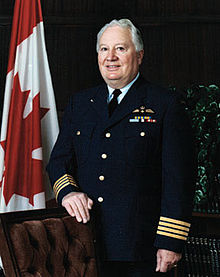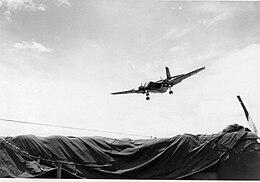Canada and the Vietnam War
[4] During the First Indochina War between France and the Indo-Chinese nationalist and communist parties, Canada remained militarily neutral but provided modest diplomatic and economic support to the French.
Canada was, however, part of the International Control Commission (along with Poland and India) that oversaw the 1954 Geneva Agreements that divided Vietnam, provided for French withdrawal, and would have instituted elections for reunification by 1956.
Behind the scenes, Canadian diplomats tried to discourage both France and the United States from escalating the conflict in a part of the world Canada had decided was not strategically vital.
At the start of the Vietnam War, Canada was a member of the International Control Commission (ICC) overseeing the implementation of the Geneva Agreements, and thus attempted to maintain an air of neutrality.
"[7][8][9] Meanwhile, Canadian industry exported military supplies and raw materials useful in their manufacture, including ammunition, napalm and Agent Orange,[10] to the United States, as trade between the two countries continued without interruption or hindrance.
Another $10 billion in food, beverages, berets and boots for the troops was exported to the U.S., as well as nickel, copper, lead, oil, brass for shell casings, wiring, plate armour and military transport.
In a perhaps apocryphal story, when a furious President Lyndon B. Johnson met with Pearson the next day, he grabbed the much smaller Canadian by his lapels and talked angrily with him for an hour.
Canada's official diplomatic position in relation to the Vietnam War was that of a non-belligerent, which imposed a ban on the export of war-related items to the combat areas.
[citation needed] Nonetheless, Canadian industry was also a major supplier of equipment and supplies to the U.S. forces, not sending these directly to South Vietnam but to the United States.
The goods included relatively benign items like boots, but also aircraft, munitions, napalm, and commercial defoliants, the use of which was fiercely opposed by anti-war protesters at the time.
[2] The 2015 CBC story paid special attention to Rob McSorley, a teen-age Army Ranger from Vancouver who was shot dead by North Vietnamese soldiers.
[24] According to Valerie Knowles, draft evaders were usually college-educated sons of the middle class who could no longer defer induction into the Selective Service System.
Deserters, on the other hand, were predominantly sons of the lower-middle and working classes who had been inducted into the armed services directly from high school or who had volunteered, hoping to obtain a skill and broaden their opportunities.
Because they were not formally classified as refugees but admitted as immigrants, there is no official estimate of how many draft evaders and deserters entered Canada during the Vietnam War.
[23] Whether or not this estimate is accurate, the fact remains that emigration from the United States was high as long as the U.S. was participating in the war militarily and maintained compulsory military service.
[37][3] In 1970, Canadian singer Gordon Lightfoot recorded his song "Sit Down Young Stranger" to express his views on Canada's acceptance of American draft evaders.
[citation needed] The influx of these young men, who, as mentioned earlier, were often well educated[23][38][39] and politically leftist, affected Canada's academic and cultural institutions, and Canadian society at large.
While some draft evaders returned to the United States after a pardon was declared in 1977 during the presidential administration of Jimmy Carter, roughly half of them stayed in Canada.
Twenty-eight years later, on March 22, 2000, while he attempted to drive a lumber truck across the US-Canada border (in Metaline Falls, Washington) he was arrested by U.S. Customs agents and jailed at Fort Sill.
Although some of these transplanted Americans returned home after the Vietnam War, most of them put down roots in Canada, making up the largest, best-educated group this country had ever received.
According to Canadian immigration historian Valerie Knowles, from 1979 to 1980 Canada admitted an estimated 60,000 of these refugees, "most of whom had endured several days in small, leaky boats, prey to vicious pirate attacks, before ending up in squalid camps".







